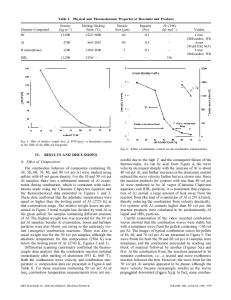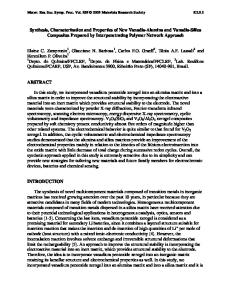Synthesis of Aerogel-Metal Cluster Composites by Gamma Radiolysis
- PDF / 402,545 Bytes
- 6 Pages / 612 x 792 pts (letter) Page_size
- 92 Downloads / 555 Views
I7.15.1
Synthesis of Aerogel-Metal Cluster Composites by Gamma Radiolysis Massimo F. Bertino1 Jared F. Hund1 Guohui Zhang2, Chariklia Sotiriou-Leventis2, Nicholas Leventis2, Akira T. Tokuhiro3, and John Farmer4 1 Department of Physics, University of Missouri-Rolla, Rolla, MO 65409, USA 2 Department of Chemistry, University of Missouri-Rolla, Rolla, MO 65409, USA 3 Department of Nuclear Engineering, University of Missouri-Rolla, Rolla, MO 65409, USA 4 MURR, University of Missouri-Columbia, Columbia, MO 65211, USA. ABSTRACT Noble metal clusters (Ag, Au) were formed in a silica aerogel matrix by gamma irradiation of hydrogel precursors loaded with aqueous solutions containing Ag+ or [AuCl4]- ions. Hydrogels exposed to gamma rays assumed the color expected for colloidal suspensions of Ag (respectively Au) clusters. The hydrogels were subsequently washed and supercritically dried, without any evident change in color, indicating that the metal clusters were not removed during drying. Typical gamma ray doses were between 3 and 3.5 kGy, and achieved complete reduction of hydrogels containing metal ion concentrations in the 10-4-10-3 M range. Metal clusters in the aerogel monoliths were characterized with optical absorption, transmission electron microscopy, X-ray diffraction, scanning electron microscopy, and X-ray photoelectron spectroscopy. These techniques have shown that the clusters have a crystalline fcc structure. Au clusters consist of pure Au, while surface oxidation of Ag clusters was observed with XPS. INTRODUCTION In situ formation and entrapment of metal clusters in aerogels is desirable for application in catalysis[1,2], sensors[3], waste disposal[4,5], and electromagnetic shielding. Metal clusters have been formed in aerogels by adding to a hydrogel a precursor, generally an organometallic compound that does not leach out during the wash cycles required prior to the final supercritical drying procedure. High temperature treatment of the dry aerogel leads to reduction and deposition of the metal particles.[1,2] Alternatively, colloidal metal particles have been added directly into the sol during gelation, and remain trapped all the way to the final aerogel.[6,7] Another efficient method of reducing metal ions to form homo- and heteronuclear clusters of transition metals is via gamma radiolysis of aqueous solutions.[8-15] That process is initiated by formation of solvated electrons, eaq- (eq 1), which reduce metal ions Mm+ to metal atoms (eqs 2, 3). Metal atoms eventually form aggregates, Mn (eq 4). γ -radiation H 2O → eaq , H3O + , H • , OH• , H 2O 2 (1) e-aq + M m+ → aq
e + M
nM 0
+
→
→
M2
M (m-1)+
(2)
M0
(3)
→
…… M n
(4)
I7.15.2
In this paper we describe the formation of nanoscopic metal clusters induced by gamma irradiation of a hydrogel in which the gelation solvent (CH3OH) has been exchanged by an aqueous solution containing ions of the desirable metal (Ag and Au). Typical work-up of the resulting metal cluster embedded hydrogels leads to aerogel-noble metal cluster nanoc
Data Loading...











